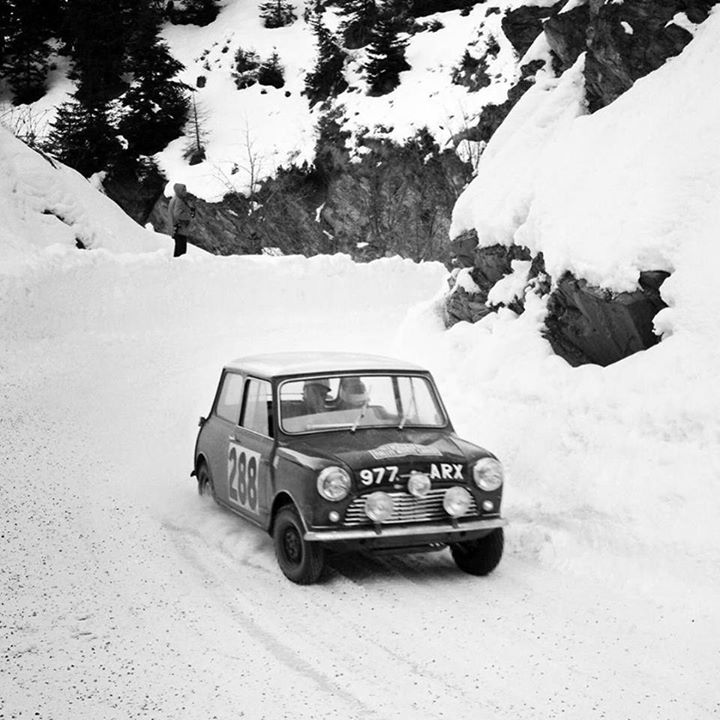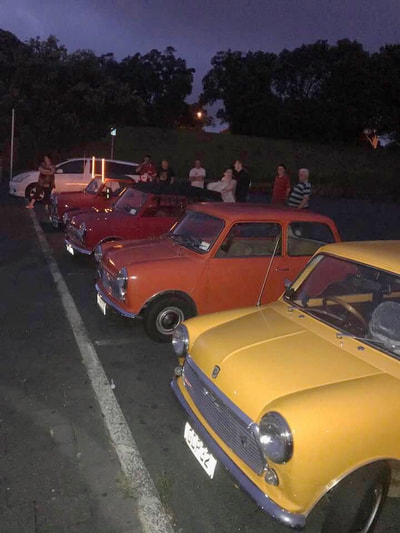We're roughly halfway through the club year, so Graham has kindly produced a table of club points so far.
|
Monte Carlo, 1963
January 2018 marks the 55th anniversary of the Mini’s appearance on the Monte Carlo dais, so by definition, the Mini’s rise to fame. Why was the Monte so important ? One reason only: sales. Britain was in the depths of winter, while Monte Carlo had a Formula I race, sunshine, casinos, and expensive yachts. The press was just itching for a good story, and here was one with glamour. The story was 9 years in the making, and this is how it unfolded. In Dec 1954, George Harriman of the Nuffield Group ordained that a Competitions Department be formed, replacing the Nuffield Competition Committee, and this Department should be based at Abingdon, not Longbridge. John Thornley, General Manager of MG was to be in charge. The Nuffield Group, Morris, Riley, Wolseley, and MG, had just merged with Austin, to form BMC, and there was a palpable aura of optimism, now that wartime steel shortages were fading. The 1955 Monte was only 6 weeks away, with the MG Club usually tasked with finding the right drivers. Thornley had just appointed Marcus Chambers to be Competitions Manager, but Chambers was not subsequently impressed with the standard of drivers he had observed on the ’55 Monte or Tulip, in April. He determined that the 1955 Tulip was the last time BMC would use drivers not chosen by him. The drivers which Chambers rated were already employed elsewhere. His only option was to build his own team, so in early 1955 John Gott from Standard, Ian Appleyard from Jaguar, and Pat Moss were lured to the BMC stable, along with Peter Riley, Tony Ambrose, and Willy Cave. Thornley selected expert mechanics for the workshop: Doug Watts, Tommy Wellman, Den Green, Cliff Humphries, Brian Moylan, and Bill Price. During the summer of 1955, two major races with BMC entries (the Le Mans, and the Ulster TT), had killed spectators. Anxious to avoid adverse publicity, the Chairman, Sir Leonard Lord, issued an edict that, without ignoring racing, the focus was to be on rallying. The new BMC was charged with taking on Triumph, and Rootes, which had signed Stirling Moss, and European makes. Until now, manufacturers rallied almost everything they made, just in case they stumbled on the magic formula, and found a winner. BMC was no exception. Through 1955, Chambers tested almost all models in the BMC stable, in an attempt to identify the most suitable models. So you might expect to see an Austin A55 entered in a rally, or an Austin Westminster doing private testing in the French Alps. Hard to believe, but there are photos. On 6th October 1955, Chambers wrote a memo to Thornley, headed, “In Desperation”, and it reads in part, “We are in desperate need of a first class rally car in the Normal Series Production Class…”, In other words, more power, more handling. The pressure to win was getting stronger, not just “see how it goes”. Normal cars, slightly modified, were the heart of all sales volumes. The public identified with, and bought, cars which they recognised. Britain had not had a win in the Monte since 1956, when Jaguar took the honours, with Sunbeam, and Standard close behind. The dominant opposition was Citroen, Mercedes and Porsche. Only 16 years after WWII, there was also a touch of nationalism, thus adding some needle to the British motor industry. The pressure was coming on: the drivers and co-drivers, the support team, and the stable all had to improve. Further, the stable should be reduced to winners only. More and more, Overall wins were sought, with Class wins only acceptable by circumstance. The mood was changing, and the heat was being turned up. The days when admonishments over the absence of eg. Wolseley from a campaign line-up were disappearing, while a sense of mission was ramping up. Following the mud and gravel of the RAC, the Monte began the rallying year in snowbound winter. Reliability was a very strong asset. Match results from these to results from the fast Tulip, and BMC had the basis of a sales campaign, hopefully backed up by results in the summertime Alpine, and the Liege-Rome-Liege rallies, this latter a real car-breaker. In 1957, the Competition Dept. Annual Report recommended that these 5 rallies were the events to focus on, because they earned the greatest international media attention. Without doubt, George Harriman saw the link between motorsport successes and sales. Since 1959, BMC had rallied the 850 with indifferent results, but not until the Cooper 997 arrived in 1961 did results start to come. So what gave the Cooper 997 this new edge? Since 1959, John Cooper, and many car clubs, had seen the handling (read racing) potential of Issigonis’ front-wheel-drive Mini, and wondered how much better it could be made. With Managing Director George Harriman’s help, he got the factory to send him one which he played around with. Prior to the advent of the Cooper, John Cooper had been racing and building racing cars, so successfully that he won the 1959 and 1960 World Constructor’s title. He then decided to opt for Formula Junior competition, using A series motors. He took the crank for the 1100 which was coming out shortly after, and put it into a block which came in just under the 1000cc limit for FJ racing. He added a 2nd SU, a different cylinder head (12G202) with bigger ports and modified chambers, bigger valves with double valve-springs, a different camshaft (the famous 88G229), higher compression, a 3-into-1 exhaust manifold, a different gearshift and different gear ratios, disc brakes, and a few interior mods. In essence, John Cooper had designed for the 997 a 1961 torquey racing engine. John Cooper took it back to Longbridge, and drove George Harriman around the grounds. Harriman was delighted, but reminded Cooper that they needed to sell 1000 for homologation. They sold 150,000. By late 1961, Chambers had had enough of the pressure, and gave notice, but suggested to Thornley that he ring someone who had had some good wins as a co-driver, had some brains, and was a reporter on Motoring News: Stuart Turner, next Competitions Manager, 1962. Turner was to develop a fearsome reputation as a rally campaign planner. The big Austin Healey and the Cooper had emerged from the stable as potential outright winners, and so Turner axed the rest of the stable. With fewer drivers needed, Turner also dropped the part-time Gentlemen drivers, because he needed faster drivers, who also could spend time recceing. Professionalism was coming. So now, building on the changing mood, BMC was acquiring better handling, faster cars, and faster drivers. In 1962, Pat Moss, in 737ABL, had won the Tulip in May, and the Geneva in September. In October, she came 3rd overall in the BadenBaden. Then Ford offered her much more money, which she couldn’t refuse. And that is how some vacancies opened up at BMC. Look who came along. Paddy Hopkirk, currently with Rootes, wrote asking for a chance to drive the big Healeys, and got a Cooper 997 instead. Turner had spotted Rauno Aaltonen at the 1961 Polish Rally, putting up very quick times on gravel, and he signed Aaltonen before anyone else did. Turner gave him a 997 for the 1962 Monte, which Aaltonen got up to 3rd, before crashing out. Then, in November, Rauno Aaltonen, in 977ARX, got 3rd in the RAC. Because Turner co-drove with Erik Carlsson for the 1960 RAC in a Saab, Turner knew that for some reason, Scandinavian drivers were fast. One day, Turner was visited by the Morris franchiser from Helsinki, enquiring whether Turner could find a car for a young Finn who was “rather quick”, and who might do reasonably well on the 1962 RAC. This young guy was told sternly to get the feel of the car, and not to bend it. His name was Timo Makinen; he got his 997 up to 7th overall, and won his Class. The Cooper 997 had been already getting some good results, the talent had arrived, the engineering skills were second to none, but most importantly, the killer instinct had developed. BMC was stunned to realise that instead of hoping for Class wins, they were now contemplating Overall wins. The scene was set. RESULTS 1963
The Mini had arrived, and this was a foretaste of the shock about to be unleashed on the world of motorsport. Chris McMurray by Gary Ashton. Photos by Phil Kane A meeting of old friends.
The alarm goes off at 4:15am on a Sunday morning. Bugger!!! We crawled out of bed and got ourselves organised and we were on the road by 4:55am. Had a good run into town, hardly anybody on the motorway. We are the first to arrive at Fred Ambler Lookout. Before too long there are 8 other groups from the club ready for the dawn breaker. Awaiting the start we chatted with old friends and new, while the container terminal below was a buzz of activity. We were set off with instructions a couple of minutes apart. We went along the waterfront through Glendowie and Tamaki, Pakuranga and headed to Whitford, Maraetai, Clevedon, up Ormiston Road and into East Tamaki for breakfast. I know most of these roads so it was like meeting old friends. A fabulous couple of hours on some brilliant roads with great people. Thanks Murray and Shirley for organising the run. For those that missed it, come along next year. |
Archives
August 2022
Categories |









 RSS Feed
RSS Feed
